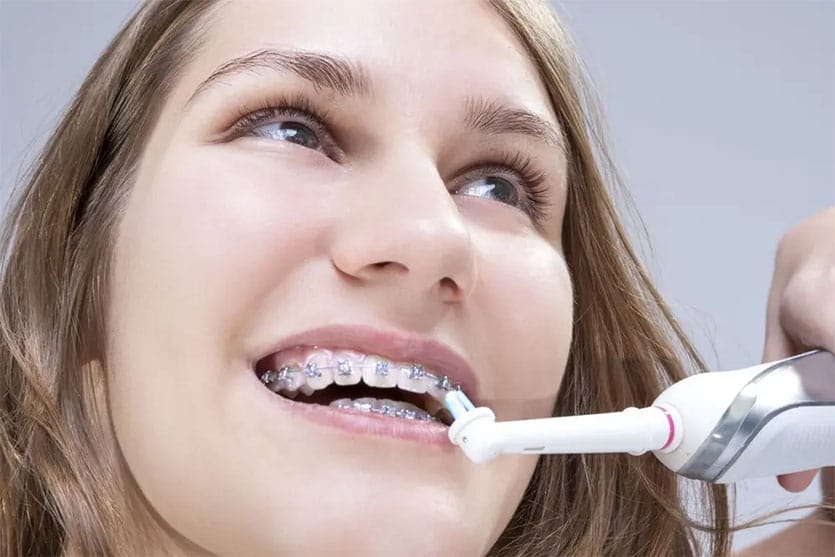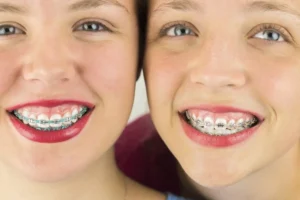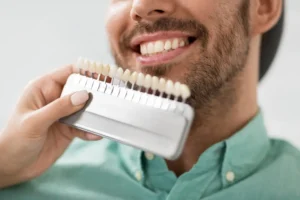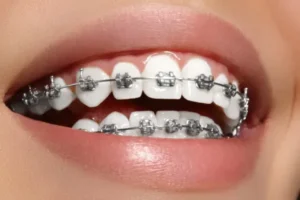Electric or Manual Which Toothbrush Should You Choose?
We’ve already reviewed the ideal time to change your toothbrush , but will wearing braces require you to change the type of toothbrush you use?
Your dentist or orthodontist might suggest a switch. They might want you to move from a manual brush to an electric one. Why? Here are some reasons:
- It removes plaque more effectively.
- Using it is easier.
- It has handy timers.
- It offers extra brush movements.
- It has useful speed and sensitivity settings
- It can connect to an app to check your brushing.
- Safe for your gums and enamel.
But what about braces? Do these safety features work with them? Can you use an electric toothbrush with braces?
Or would a hand-operated one be superior? Let’s discover. Continue reading to gain more knowledge.

How to Use An Electric Toothbrush for Braces
Electric toothbrushes are safe to use with braces. In fact, when used correctly, they can be safer and more effective than a regular toothbrush. Dentists recommend electric toothbrushes for braces effectiveness.
The brushing methods for both types of toothbrushes are quite similar. So, you don’t need to learn a new brushing technique when switching to an electric toothbrush.
Start by rinsing the brush head and applying toothpaste. Spend 30 seconds on each of the four sections of your teeth.
Position the brush at a 45-degree angle and move it slowly back and forth. Focus on the surface of the teeth, and the top and bottom parts of the braces. For a thorough clean, also brush around the tongue. Finally, spit, rinse, and enjoy your clean smile!
The 45-degree angle is important. It increases the contact with the areas that need cleaning and reduces the pressure on the braces. Don’t forget to floss and rinse with mouthwash for 30 seconds. For added cleanliness, use a Waterpik irrigator or an inter-dental brush.
You should not worry about damaging your braces with any speed or sensitivity setting. However, it’s wise to be cautious. Experiment to find the best speed and pressure settings for you.
You can clean your teeth with fluoride toothpaste without compromising the stability of your appliance. Remember, cleanliness should not come at the cost of stability.
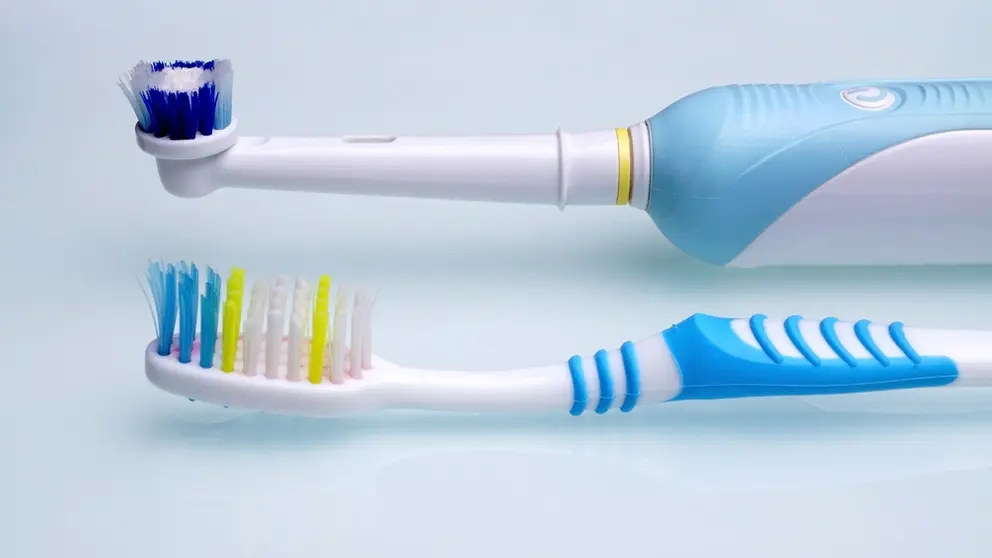
Better for Braces: Electric Toothbrush or Manual?
When considering how to brush safely with braces, it’s essential to focus on technique rather than just the tool. Whether you choose a manual or electric toothbrush, the key lies in how you use it. This approach is similar to driving a high-end car like a Lamborghini. Even if you own an expensive car, it won’t benefit you if you drive carelessly and end up crashing.
The same principle applies to brushing with braces. The picking between a manual vs. electric toothbrush with braces; it’s also about using the chosen toothbrush effectively to maintain oral hygiene with braces.
The same logic applies to toothbrushes; a built-in timer could become useless if you totally ignore it, just as the sensitivity settings could if you decide to manually exert too much (or too little) pressure. both manual and electric toothbrushes can be sufficient for cleaning braces if you use them properly.
That said, there’s evidence that it might be easier to meet that efficiency with electric brushes than manual ones. Brushes with app compatibility, like certain models offered by Oral-B, can measure brush performance to give you a better picture of what you’re doing right, and what you could improve on. Likewise, the motor enhancement offers a somewhat deeper clean than your hands could accomplish manually.
While a manual toothbrush has been measured to complete 300-600 brush movements a minute, electric toothbrush models can easily complete thousands, to even tens of thousands, of movements within a single minute.
Of course, it’s logical to think that this means a more thorough cleaning, and you’d be right: a study by Cochrane suggests that electric toothbrushes might be 11% better at eliminating plaque compared to manual brushes. While manual brushes are usually perfectly fine for getting the job done, you may want to consider switching to electric if you find that it’s not getting the job done for you.
Which Electric Toothbrush HEAD Is Best for Braces?
You can use any toothbrush safely with braces if you handle it correctly. However, we strongly suggest using a toothbrush with a small, snug, and soft-bristled head for the best safety and comfort. This is crucial for proper care during your braces treatment.
To minimize waste and maximize reusability, avoid disposable electric brushes. Instead, choose models that allow you to replacing brush heads. This approach ensures you get the best toothbrush for braces care. Remember, the right toothbrush can make a significant difference in your braces treatment journey.
For adult teeth, it’s recommended that you stick to a brush head that is circular, a half-inch wide, and one-inch tall. That brush head size should be small enough to safely and nimbly clean even the hardest-to-reach areas. Nimble agility is all the higher a priority when you have to carefully navigate with a fixed orthodontic appliance in place.

Which Electric Toothbrush Is Best for Braces?
Some of the most popular electric toothbrush brands you’ll find on the market include:
- Oral-B
- Philips Sonicare
- Quip
- Burst
People widely recognize and use these product lines. They have a reputation for being robust, well-made, and highly effective. You could choose any of these brands or even another electric toothbrush brand. In most cases, a manual brush could also serve the purpose.
Now, let’s talk about “Orthodontic Appliance Cleaning Techniques”. It’s crucial to keep your orthodontic appliances clean.
One effective way is to ensure they are brushed and flossed regularly. This helps maintain their effectiveness and longevity. Remember, a clean appliance is a happy appliance!
However, no matter what kind of electric toothbrush you choose, you should look for these essential qualities:
- Interchangeable brush heads, ideally with the specifications described above.
- Timer and pressure sensor to reinforce optimal brushing performance
- Refund policy, so won’t unnecessarily waste money if the model dissatisfies you
- An advertised back-and-forth oscillating motion
Back and forth motor oscillation plays a crucial part in accomplishing those tens of thousands of brush movements per minute. You don’t need a fancy brush. Built-in timers and pressure sensors can evaluate how well you brush your teeth and ensure safety.
We encourage you to choose a brush that suits your needs. Brush your teeth diligently for at least two minutes, twice a day. This is a good idea whether you wear braces or not. Regular brushing forms the foundation of good oral hygiene and contributes to a beautiful smile.
Consider using sonic toothbrushes. They are effective in maintaining oral hygiene. Interdental brushes are also a good option, especially for those with braces or Invisalign. They help clean areas that are hard to reach with regular brushes.
Remember, mindful and responsible brushing is key to good oral health. So, make it a part of your daily routine and keep smiling!
